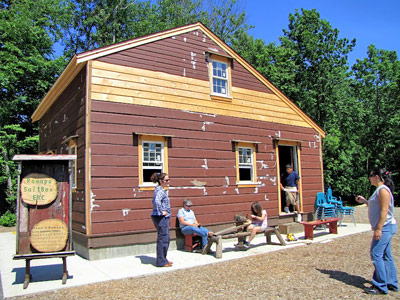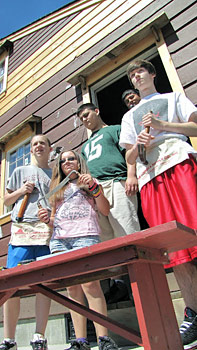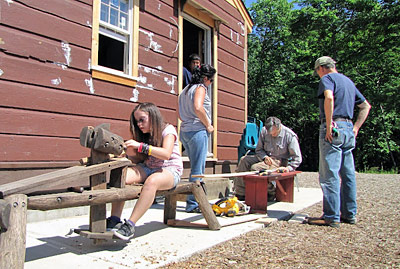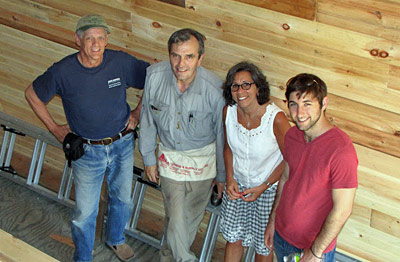Under a bright blue Thursday afternoon sky, BOCES students finished their last trip to the Saltbox House along Torne Valley Road in Hillburn, where they’ve been coming  like clockwork all year to lend a helping hand. Whether sanding down old planks or fashioning furniture out of repurposed boards, high school students from the BOCES PAVE Program have held class with Cornell University Cooperative Extension and Ramapo College Environmental Educator Chuck Stead most Tuesdays and Thursdays as they rebuild a piece of Ramapo history. Part job skills program, part environmental education class, the BOCES students have participated in all stages of the restoration, design, and construction of the 19th century Ramapo Hamlet house.
like clockwork all year to lend a helping hand. Whether sanding down old planks or fashioning furniture out of repurposed boards, high school students from the BOCES PAVE Program have held class with Cornell University Cooperative Extension and Ramapo College Environmental Educator Chuck Stead most Tuesdays and Thursdays as they rebuild a piece of Ramapo history. Part job skills program, part environmental education class, the BOCES students have participated in all stages of the restoration, design, and construction of the 19th century Ramapo Hamlet house.
 “Unofficially I’ve been using it as a classroom since September,” Stead said. He’s aiming for an October official opening of the Ramapo Saltbox Environmental Research Center (ERC), a field research center that will examine the long-range impact of watershed paint sludge contamination, the result of Ford Motor Company’s dumping around Ramapo and the Torne Mountain watershed during the 1960’s and 70’s.
“Unofficially I’ve been using it as a classroom since September,” Stead said. He’s aiming for an October official opening of the Ramapo Saltbox Environmental Research Center (ERC), a field research center that will examine the long-range impact of watershed paint sludge contamination, the result of Ford Motor Company’s dumping around Ramapo and the Torne Mountain watershed during the 1960’s and 70’s.
Stead said the rebuilt house sits adjacent to the contaminated wetland as both a history museum to the old iron works and also a lab to study watershed paint sludge contamination. “So, it’s not just a museum to the iron works, it’s a museum to contamination, a museum to the impact and changes to the land in all of these 200 years,” he said.
Two BOCES classes have held classes this year either at the saltbox house itself or the Shed, which sits across the street from the Torne Center and serves as the base camp for the reconstruction project. The original 19th-century house at one time stood in Ramapo Hamlet, which was an old work camp for the Ramapo Iron Works.
 Thursday, students worked on a shaving horse to make timber pegs that will be used for peg and post beams. They also worked on installing interior tongue and groove pine wall boards. Stead will continue the reconstruction project throughout the summer, where he will teach a summer course in environmental sustainability for Ramapo College students. Each step of the way, Stead and his students have handcrafted the various parts of the house, from timber beams and sheathing to furniture, staying as close as possible to construction methods of the period.
Thursday, students worked on a shaving horse to make timber pegs that will be used for peg and post beams. They also worked on installing interior tongue and groove pine wall boards. Stead will continue the reconstruction project throughout the summer, where he will teach a summer course in environmental sustainability for Ramapo College students. Each step of the way, Stead and his students have handcrafted the various parts of the house, from timber beams and sheathing to furniture, staying as close as possible to construction methods of the period.
 The house won’t be an exact historical restoration, said Stead, as the reconstruction process has had to pass contemporary codes and inspections. But the salt box house itself will get wrapped in original material — boards and timber — and look very close to what it might have looked like originally, with a lot of modern modifications.
The house won’t be an exact historical restoration, said Stead, as the reconstruction process has had to pass contemporary codes and inspections. But the salt box house itself will get wrapped in original material — boards and timber — and look very close to what it might have looked like originally, with a lot of modern modifications.
Support and partial funding for the project comes directly from the Town of Ramapo’s Cultural Property Management department, headed up by Tom Sullivan. Part of the Open Spaces initiative by Supervisor Christopher St. Lawrence, the department oversees historical properties throughout Ramapo, including Harmony Hall in Sloatsburg, Henry Varnum Poor House (of Standard & Poor fame), the Smith Family Farm, and Mobray-Clarke House.
Source: Photos courtesy of Geoff Welch.


